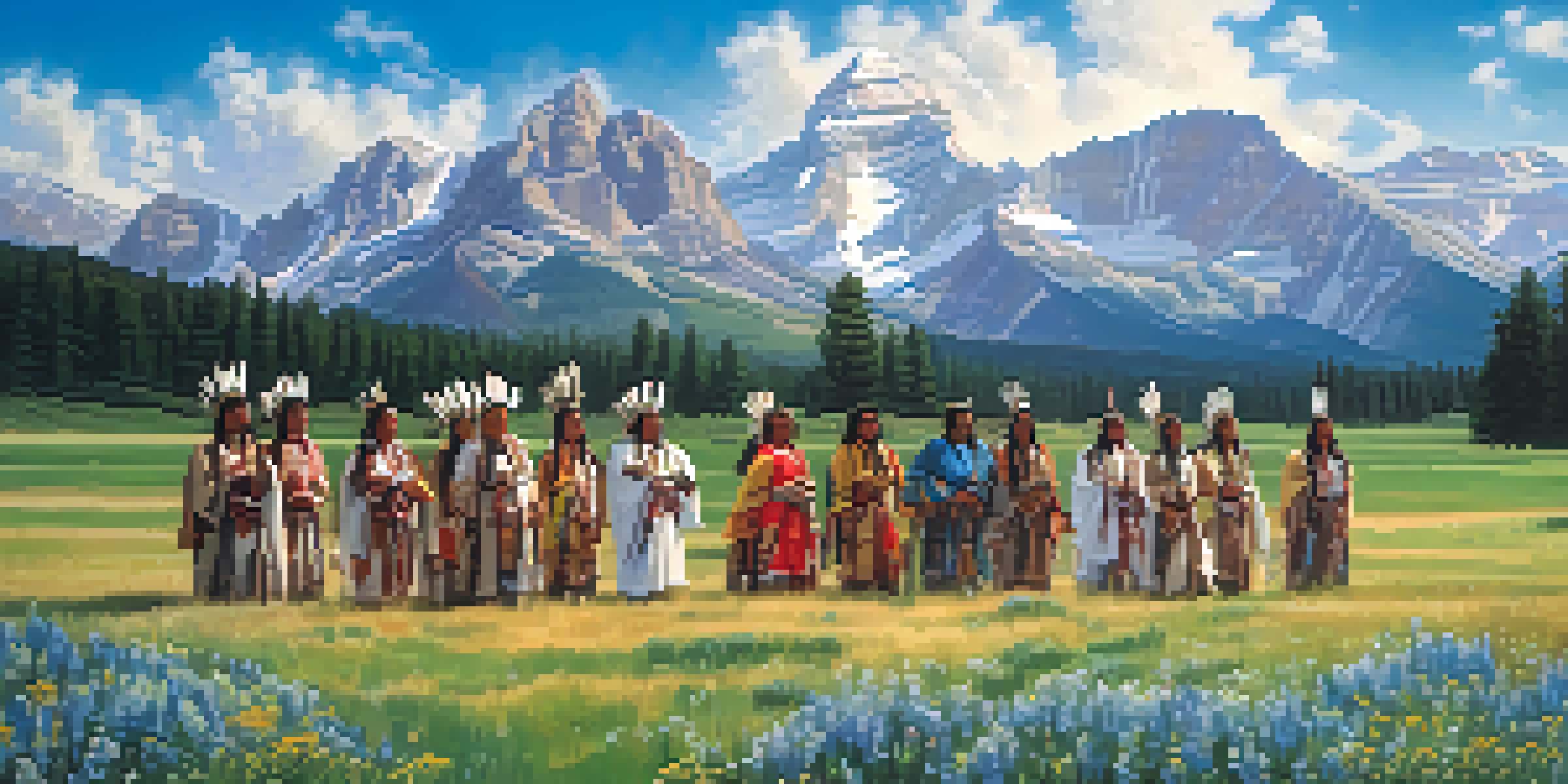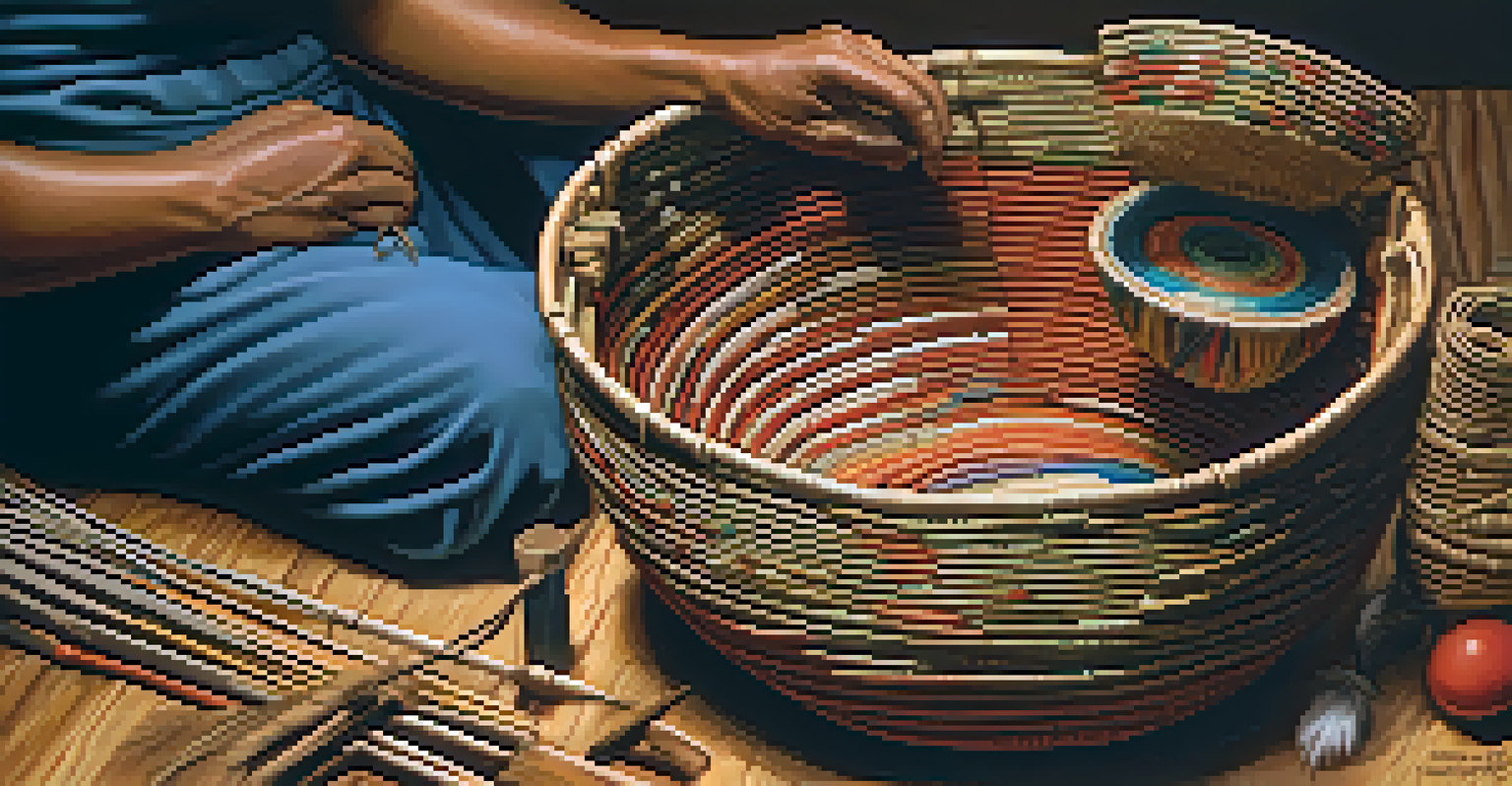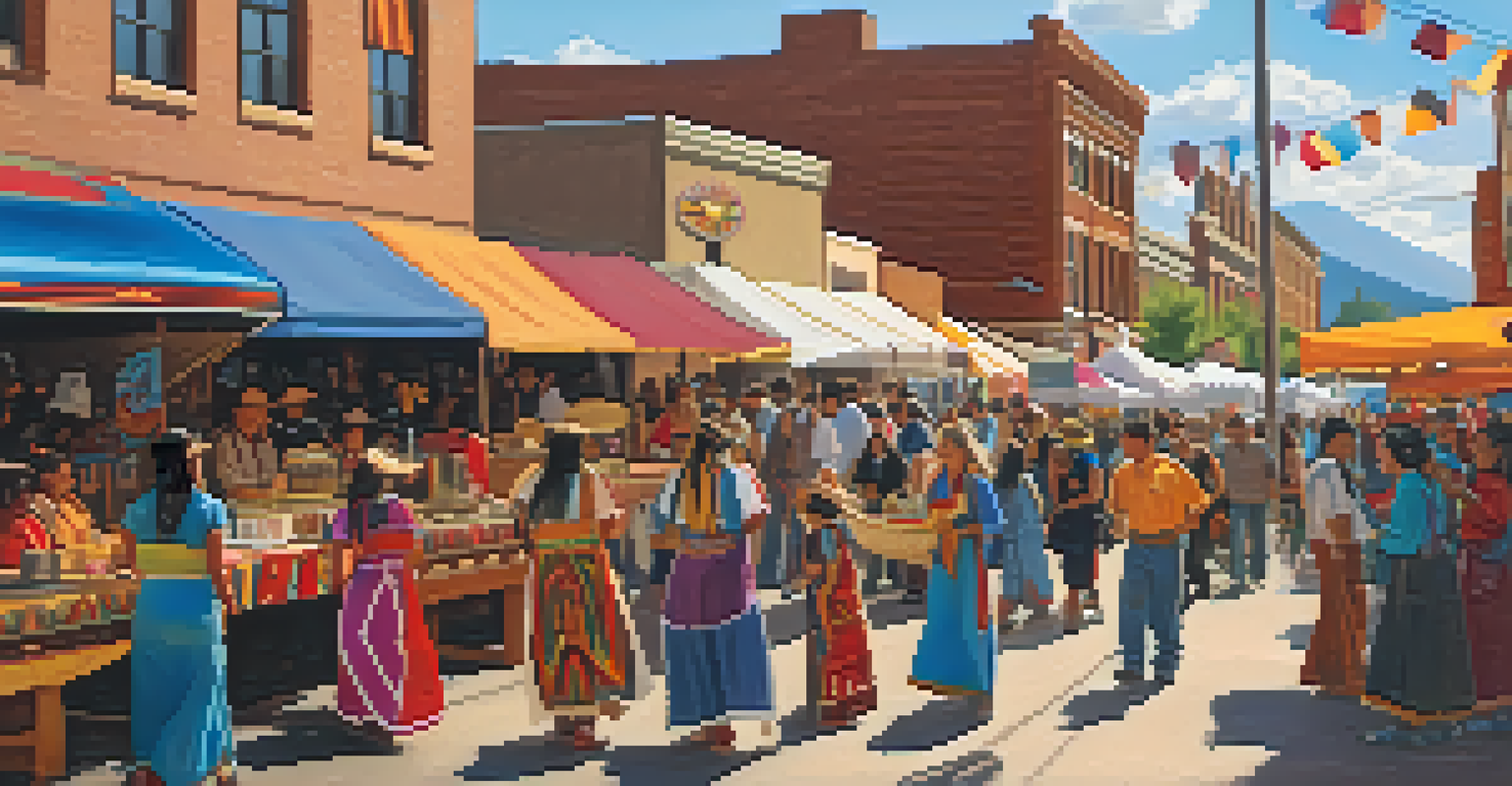The Role of Native Tribes in Colorado's Early Settlements

Understanding Colorado's Indigenous Tribes
Before European settlers arrived, Colorado was home to diverse Native tribes, including the Ute, Cheyenne, and Arapaho. These groups had rich cultures, languages, and traditions that were deeply connected to the land. They utilized the region's natural resources for sustenance, crafting, and trade, which laid the groundwork for future settlements. Understanding these tribes is essential for appreciating the history of Colorado.
The land is sacred. It is the birthplace of our ancestors. It is the land on which we stand, and it is the land that sustains us.
Each tribe had its own unique way of life, shaped by the distinct landscapes of Colorado. For example, the Ute people were primarily hunter-gatherers, adept at navigating the mountainous terrain. In contrast, the plains tribes, like the Cheyenne, relied on the vast grasslands for hunting buffalo. This diversity in lifestyle highlights how the tribes adapted to their environments, showcasing resilience and resourcefulness.
The traditions and practices of these tribes not only influenced their communities but also laid the foundation for interactions with early settlers. As newcomers arrived, they encountered various indigenous practices that would shape their understanding of the land. Recognizing the significance of these tribes is crucial for grasping the complex tapestry of Colorado's early history.
The Impact of Native Tribes on European Settlers
When European settlers began to arrive in the 19th century, they were met with established Native tribes who had a profound understanding of Colorado's terrain. Many settlers relied on the indigenous peoples for guidance in navigating the challenging landscapes. This mutual exchange of knowledge was vital, as it helped settlers understand local resources, such as water sources and edible plants.

Furthermore, Native tribes engaged in trade with settlers, providing them with essential goods like furs and food in exchange for metal tools and other supplies. This trade relationship was beneficial for both parties, fostering a sense of cooperation amidst the challenges of frontier life. However, it also highlighted the complexities of cultural exchange, as differing worldviews sometimes clashed.
Cultural Exchange Shaped Colorado
The interaction between Native tribes and European settlers resulted in a significant cultural exchange that enriched both groups.
Despite these interactions, the arrival of settlers often led to tensions and conflicts over land and resources. As settlers expanded into indigenous territories, many tribes faced displacement and loss of their ancestral lands. This intricate relationship between Native tribes and European settlers underscores the challenges of coexistence during Colorado's early settlement period.
Cultural Exchange and Adaptation
The interaction between Native tribes and European settlers resulted in a significant cultural exchange that affected both groups. Settlers adopted certain indigenous practices, such as using Native American farming techniques that proved effective in the Colorado climate. This adaptation played a crucial role in the survival of early settlers, showcasing the ingenuity of both cultures.
We do not inherit the earth from our ancestors, we borrow it from our children.
Conversely, Native tribes were influenced by European customs, incorporating new tools and materials into their daily lives. For instance, the introduction of horses transformed the mobility and hunting practices of various tribes, enhancing their way of life. These exchanges illustrate how cultures can blend and evolve when faced with new challenges and opportunities.
However, the complexity of this cultural exchange also brought about misunderstandings and conflicts. As settlers imposed their values and systems on indigenous peoples, tensions escalated, leading to a struggle for power and identity. This dynamic highlights the duality of cultural exchange, where both enrichment and conflict can arise.
The Role of Native Tribes in the Fur Trade
The fur trade was a significant economic driver in Colorado's early settlements, and Native tribes played a crucial role in this industry. Indigenous peoples were skilled trappers and hunters, providing valuable pelts to European traders. Their expertise in navigating Colorado's rugged landscapes made them indispensable partners in the fur trade, demonstrating their vital contributions to the economy.
Traders often relied on Native tribes to establish trade routes and connect with other indigenous communities. This network facilitated the exchange of goods, ideas, and cultures across the region. In many ways, Native tribes were the backbone of the fur trade, bridging the gap between European settlers and the vast resources of the land.
Land Displacement's Lasting Effects
The forced displacement of Native tribes led to profound cultural, emotional, and economic consequences that continue to affect indigenous communities today.
However, the fur trade also had negative consequences, leading to overhunting and depletion of resources that affected indigenous communities. As demand for furs grew, the pressures on wildlife and natural habitats intensified, resulting in significant ecological changes. This aspect of the fur trade highlights the complex legacy of economic relationships between Native tribes and settlers.
Land Displacement and Its Consequences
As European settlers continued to arrive, land displacement became an unfortunate reality for many Native tribes in Colorado. Treaties were often signed under duress or misunderstanding, leading to the loss of ancestral lands. This disregard for indigenous rights not only disrupted their way of life but also caused deep emotional and cultural ramifications for the tribes.
The loss of land impacted traditional practices, including hunting, gathering, and spiritual ceremonies that were tied to specific locations. As tribes were pushed onto reservations or forced to adapt to new environments, their cultural identity faced significant challenges. This struggle for preservation is a poignant aspect of Colorado's history.
In addition to cultural consequences, the displacement also had economic impacts, as tribes lost access to vital resources. This created a cycle of poverty and marginalization that continues to affect indigenous communities today. Recognizing the historical injustices faced by Native tribes is essential for understanding the ongoing challenges they encounter.
Resilience and Adaptation of Native Tribes
Despite the numerous challenges posed by early settlers, Native tribes in Colorado demonstrated remarkable resilience and adaptability. Many tribes worked to preserve their cultural heritage even as their traditional ways of life were disrupted. This determination to maintain identity and traditions is a testament to their strength and cultural richness.
In more recent years, there has been a resurgence of interest in Native American culture and history. Many tribes are actively working to revitalize their languages, traditions, and ceremonies, fostering a renewed sense of pride among members. This cultural revival not only strengthens tribal communities but also enriches the broader tapestry of Colorado's social fabric.
Resilience of Native Tribes Today
Native tribes in Colorado demonstrate remarkable resilience by revitalizing their cultures and advocating for their rights in modern society.
Moreover, Native tribes have become advocates for their rights and recognition, seeking to address historical injustices. Through education and outreach efforts, they aim to raise awareness about their contributions to Colorado's history and promote a more inclusive narrative. This journey of resilience and advocacy reflects the enduring spirit of Native tribes in the face of adversity.
The Legacy of Native Tribes in Colorado Today
The legacy of Native tribes in Colorado is evident in today’s cultural landscape, where their influence can be seen in art, music, and community events. Many tribes actively share their stories and traditions with the broader public, fostering a greater understanding of their history. This engagement helps bridge gaps between cultures and promotes a sense of unity in diversity.
Additionally, Native tribes continue to play an important role in environmental stewardship, drawing on traditional ecological knowledge to advocate for sustainable practices. Their deep connection to the land positions them as vital allies in contemporary conservation efforts. This approach not only honors their heritage but also contributes to the health of Colorado's ecosystems.

Recognizing the contributions and challenges faced by Native tribes is essential for building a more inclusive future. As Colorado continues to grow and evolve, the stories of its indigenous peoples remain an integral part of its identity. Embracing this legacy will foster mutual respect and understanding, paving the way for stronger relationships among all communities.